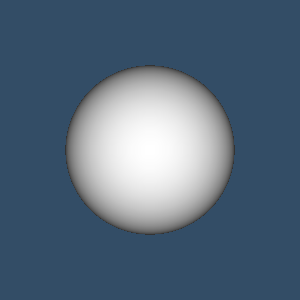ImplicitSphere
Repository source: ImplicitSphere
Description¶
This example creates a polygonal model of two spheres and 3 tubes, and then renders it to the screen. It will rotate the scene 360 degrees and then exit. The basic setup of source -> mapper -> actor -> renderer -> renderwindow is typical of most VTK programs.
Other languages
See (Cxx), (Python), (PythonicAPI), (CSharp)
Question
If you have a question about this example, please use the VTK Discourse Forum
Code¶
ImplicitSphere.java
//
// This example creates a polygonal model of two spheres and 3 tubes, and then renders it to
// the screen. It will rotate the scene 360 degrees and then exit. The basic
// setup of source -> mapper -> actor -> renderer -> renderwindow is
// typical of most VTK programs.
//
// We import the vtk wrapped classes first.
import vtk.*;
// Then we define our class.
public class Sphere {
// In the static contructor we load in the native code.
// The libraries must be in your path to work.
// Loading Native Libraries.
// Now it works in eclipse without any issues.
static {
if (!vtkNativeLibrary.LoadAllNativeLibraries()) {
for (vtkNativeLibrary lib : vtkNativeLibrary.values()) {
if (!lib.IsLoaded()) {
System.out.println(lib.GetLibraryName() + " not loaded");
}
}
}
vtkNativeLibrary.DisableOutputWindow(null);
}
// Now the main program
public static void main (String []args) {
//
// Next we create an instance of vtkSphereSource and set some of its
// properties. The instance of vtkSphereSource "sphere" is part of a
// visualization pipeline (it is a source process object); it produces data
// (output type is vtkPolyData) which other filters may process.
//
vtkSphereSource sphere = new vtkSphereSource();
sphere.SetRadius( 1.0 );
sphere.SetPhiResolution(12);
sphere.SetThetaResolution( 12 );
vtkSphereSource sph = new vtkSphereSource();
vtkAppendPolyData apf = new vtkAppendPolyData();
vtkPolyData pd = new vtkPolyData();
vtkTubeFilter tubes = new vtkTubeFilter();
vtkCellArray polys = new vtkCellArray();
vtkPoints points = new vtkPoints();
points.Allocate(10, 10);
polys.Allocate(10, 10);
pd.Allocate(10, 10);
sph.SetCenter(3, 0, 2);
sph.SetRadius(2);
sph.SetThetaResolution(25);
sph.SetPhiResolution(25);
sph.Update();
points.InsertNextPoint(3, 0, 2);
points.InsertNextPoint(3, 3, 3);
points.InsertNextPoint(5, 3, 3);
points.InsertNextPoint(2, 4, 2);
points.InsertNextPoint(4,4,4);
polys.InsertNextCell(2);
polys.InsertCellPoint(0);
polys.InsertCellPoint(1);
polys.InsertNextCell(2);
polys.InsertCellPoint(1);
polys.InsertCellPoint(2);
polys.InsertNextCell(2);
polys.InsertCellPoint(2);
polys.InsertCellPoint(3);
polys.InsertNextCell(2);
polys.InsertCellPoint(3);
polys.InsertCellPoint(1);
pd.SetLines(polys);
pd.SetPoints(points);
tubes.AddInput(pd);
tubes.SetRadius(.25);
tubes.SetNumberOfSides(9);
tubes.Update();
apf.AddInput(tubes.GetOutput());
apf.AddInput(sphere.GetOutput());
apf.AddInput(sph.GetOutput());
//
// In this example we terminate the pipeline with a mapper process object.
// (Intermediate filters such as vtkShrinkPolyData could be inserted in
// between the source and the mapper.) We create an instance of
// vtkPolyDataMapper to map the polygonal data into graphics primitives. We
// connect the output of the sphere souece to the input of this mapper.
//
vtkPolyDataMapper sphereMapper = new vtkPolyDataMapper();
sphereMapper.SetInput( apf.GetOutput() );
//
// Create an actor to represent the sphere. The actor orchestrates rendering
// of the mapper's graphics primitives. An actor also refers to properties
// via a vtkProperty instance, and includes an internal transformation
// matrix. We set this actor's mapper to be sphereMapper which we created
// above.
//
vtkActor sphereActor = new vtkActor();
sphereActor.SetMapper( sphereMapper );
//
// Create the Renderer and assign actors to it. A renderer is like a
// viewport. It is part or all of a window on the screen and it is
// responsible for drawing the actors it has. We also set the background
// color here
//
vtkRenderer ren1 = new vtkRenderer();
ren1.AddActor( sphereActor );
ren1.SetBackground( 0.1, 0.2, 0.4 );
//
// Finally we create the render window which will show up on the screen
// We put our renderer into the render window using AddRenderer. We also
// set the size to be 300 pixels by 300
//
vtkRenderWindow renWin = new vtkRenderWindow();
renWin.AddRenderer( ren1 );
renWin.SetSize( 300, 300 );
//
// Now we loop over 360 degrees and render the sphere each time
//
int i;
for (i = 0; i < 360; ++i)
{
// render the image
renWin.Render();
try {
Thread.sleep(100);
} catch (Throwable e) {
e.printStackTrace();
}
// rotate the active camera by one degree
ren1.GetActiveCamera().Azimuth( 1 );
}
try {
Thread.sleep(1000);
} catch (Throwable e1) {
e1.printStackTrace();
}
}
}
